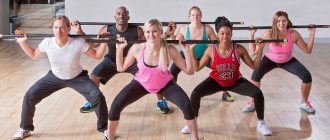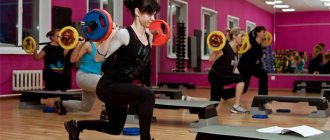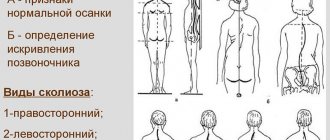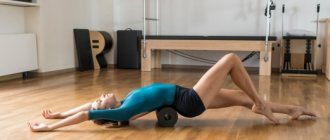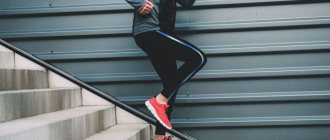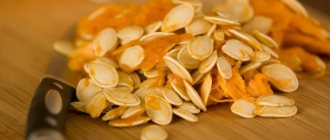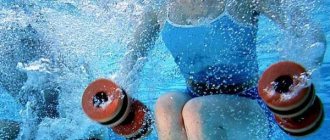Share:
What you need
- Dumbbells
- Barbell
- Horizontal bar
- Exercise equipment
- Fitball
We often hear from various fitness bloggers that without doing basic exercises there can be no growth. What confirms their effectiveness? In this article we will try to answer this question, and also figure out how to do basic basic exercises and how to implement them into your training process.
The best basic exercises for different muscles
There are both basic and isolation exercises for each muscle group. It is especially important to perform basic exercises for beginner athletes. This way, you will quickly build a certain strength base, from which it will later be easier for you to build muscle, improve the functionality of your body, or increase record weights in strength movements. But it is not recommended for experienced athletes to abandon the base; in any case, it should make up the majority of your program.
It is worth noting that not all athletes will benefit from regular exercise. Many of them (such as deadlifts and squats) involve a strong axial load on the spine. It is not recommended to perform them for herniated discs and protrusions, especially in the lumbar region. In addition, performing these exercises with large working weights is quite a traumatic activity, and the slightest deviation from the correct technique can not only aggravate existing health problems, but also cause new ones to arise.
For beginners who train without a trainer, it is also better not to include deadlifts and squats with a barbell in their program, since learning the technique from scratch on your own will be quite difficult. It is better to first develop skills in working with iron using simpler basic exercises, and only then move on to complex ones. Or immediately start working with a trainer.
Below we provide a list of basic exercises for each muscle group. They are suitable for both men and women, the most important thing about them is the correct technique.
Basic leg exercises
Let's first talk about basic leg exercises. After all, many ignore this muscle group, but in vain.
Squats
Barbell squats are one of the fundamental exercises in many sports. In this movement, almost all muscle groups of your body work in one way or another. The main dynamic load falls on the quadriceps, hamstrings, spinal extensors, gluteal muscles and hip adductors. When working with serious weight, a significant static load falls on the abdominal muscles, shoulders and trapezius muscles.
The main thing in this exercise is to monitor your breathing (exhale strictly when lifting) and keep your back straight throughout the entire movement - this way you will protect yourself from injury.
© Vitaly Sova — stock.adobe.com
A clear position of the head helps stabilize the movement - the gaze should be directed strictly in front of you or slightly upward, this will make it psychologically easier for you to get up from a lower position.
Don't forget about the position of your feet - in general, they should be spaced slightly wider than your shoulders, with your toes pointing to the sides. When rising from a squat, never bring your knees together.
This also includes squats in Smith and hack machine. These movements are a little simpler in terms of technique. The general principle is the same, but the position of the body and the projectile is more fixed, which is why fewer stabilizer muscles are involved in the work.
© mountaira — stock.adobe.com
Leg press
The platform leg press cannot fully replace heavy squats with a barbell, but the load on the legs is no less: the front, back and inner thighs and gluteal muscles work. Perfect for beginners for whom the squat technique will be too difficult at the initial stage.
The most important thing in this exercise is not to overdo it with the working weight. This will make it more difficult for you to control the correct position of your knees. If you bring them inside the trajectory of movement, you risk injury to the ligaments.
It is also important to work in a comfortable amplitude. Do not try to lower the platform as low as possible. The geometry of most exercise machines is designed in such a way that at the lowest point your spine will be rounded in the tailbone area. This is an extremely traumatic position. At the top point, you don’t need to straighten your knees all the way, leave them slightly bent.
Lunges
You can perform lunges with your own weight, with a barbell or dumbbells. In any variation, you will use all areas of the leg muscles. Depending on the width of the step, the direction of movement and the position of the foot, you can slightly emphasize the load on one or another area: with a shorter step, the emphasis falls on the quadriceps, with a wide one, on the hamstrings.
If you perform a step in such a way that at the bottom point the angle between the shin and the thigh of both legs is 90 degrees, the load is equally distributed on the front and back surfaces of the thigh.
Sumo deadlift
This is a variation of the classic deadlift, in which the emphasis shifts to the legs (adductors, quadriceps and hamstrings) and works the back to a lesser extent. This is achieved through wider stance of the legs. The range of motion in a sumo stance is a little shorter, but this does not eliminate the powerful static tension in the abdominal muscles, back, trapezius and arms.
The correct technique for performing a sumo deadlift involves a deep squat in the starting position and maintaining a straight back throughout the entire exercise. This way you minimize the risk of back injury or umbilical hernia.
Athletes who are not involved in powerlifting should avoid using an underhand grip, as it can also lead to spinal injury. Use a regular overhand grip; you can attach straps if the weight is too heavy.
Romanian deadlift
It is often mistakenly called a deadlift, although in fact a deadlift is a regular classic deadlift. In the Romanian version, the legs remain slightly bent throughout the entire approach; the work is mainly carried out by the extensors of the spine and biceps of the thigh. That is why this exercise can be considered a basic one for the back. It’s also a good idea to include the gluteal and other additional stabilizers (trapezius, calf, etc.).
There is no need to perform this movement with fully straightened legs, as this can cause injury. The angle of the knees should not change throughout the entire approach. The bend should be done to a comfortable point, stretching is different for everyone, and should not be done through pain. It is also important not to hunch your back; if you can’t do this, reduce the working weight.
Another version of this exercise is with dumbbells, the technique here is identical, but the emphasis shifts more to the gluteal muscles.
Basic exercises for the back
Now let's talk about how to achieve a powerful muscle corset and rock your back.
Pull-ups on the horizontal bar
The crossbar is a wonderful exercise machine with which you can work the entire muscle mass of the upper back. If you do a wide-grip pull-up, the work involves the latissimus dorsi, trapezius and rhomboids, the posterior deltoid muscles, as well as the teres major and minor muscles.
If you use a narrower grip, the arm muscles will be strongly involved in the work: biceps, brachialis and forearms. To partially reduce the load on your arms, use wrist straps. If you want to stress your back muscles even more, do a slight arch in the thoracic spine and squeeze your shoulder blades together at the top of the amplitude.
Pull-ups (as well as pull-downs on a vertical block) are recommended to be performed only by people with a flexible shoulder girdle. In general, it is better to perform this movement towards the chest to avoid injury to the shoulder joints.
This group of exercises includes all vertical rows on a block, as well as pull-ups on a gravitron - this is a special exercise machine with a counterweight that facilitates movement. Pulldowns use the same muscles, but are slightly less effective. They are well suited for beginners who do not have enough strength to pull themselves up, as well as for those who do not know how to “turn on” their back and pull themselves up using their arm muscles.
© Makatserchyk — stock.adobe.com
Bent-over barbell or dumbbell row
Horizontal rows thicken your back, which is important for building a massive torso. Bent-over barbell rows target the entire upper back, rear deltoids, and biceps. Also, a strong static load is placed on the spinal extensors and abdominal muscles.
Experienced athletes can focus the load on one or another area of the latissimus muscles. If you want to put more stress on your lower lats, use a reverse grip and pull the bar straight toward your waist. If your goal is a strong upper lat, rhomboid, and trapezius, work with an overhand grip and lift the barbell toward the bottom of your ribcage.
The tilt is also important; many athletes lean forward only a little, which reduces the range of motion and places emphasis on the trapezius. It is optimal to bend to an angle of approximately 30 degrees relative to the floor.
© Makatserchyk — stock.adobe.com
Bent-over dumbbell rows help pump up your back just as well. This is a one-way movement, so the stabilizer muscles will work even more here: the spinal extensors, abs and deltoids. It is recommended to perform both of these exercises with moderate weight and not to use cheating (swinging the body). It is much more important to engage the back muscles as much as possible, bringing the shoulder blades together at the top point, than to try to throw a barbell or dumbbell up in every possible way.
This also includes rowing a barbell to the waist while lying on an inclined bench. This exercise is good because the static position of the body eliminates cheating and also reduces the load on the lower back. The working weight is taken less than with a regular standing deadlift.
© Makatserchyk — stock.adobe.com
Another variation is traction on a horizontal block. It also targets the thickness of the back and uses the same muscle groups. If you take a wide handle instead of a narrow one and take it wider than your shoulders, you can shift the emphasis to the rear deltoid.
© tankist276 — stock.adobe.com
T-bar row
Almost every modern gym has a special machine for working out the back muscles - the T-bar. They come in two types: with and without chest support. A variation of the T-bar row with a chest support allows you to almost completely imitate the performance of a bent-over barbell row while lying on an incline bench.
Another plus of this machine is that there are more grip variations. For example, a narrow parallel grip allows you to perfectly work the middle of the back; you cannot imitate such a movement by working only with a barbell or dumbbells.
If your gym doesn’t have such a machine, it doesn’t matter. You can imitate the T-bar row using a regular Olympic barbell and a handle with a narrow parallel grip from a block back machine. In any case, this exercise is worth doing on a regular basis - your back will quickly become more lumpy and massive.
Classic deadlift
Deadlifts with classic leg positioning involve shifting the load to the back muscles. However, the legs are also involved quite strongly, and although this movement is traditionally classified as a back exercise, it can also be considered basic for the legs.
The classic stance involves placing your feet shoulder-width apart, your hands holding the barbell a little wider, and doing a slight squat and leaning forward. Keep the barbell as close to your shin as possible, then the trajectory of movement will be strictly vertical. The legs work here only at the moment the bar lifts off the floor; mainly the buttocks and quadriceps work. But you go through the upper 2/3 of the amplitude due to the work of the spinal extensors. A strong static load falls on all the muscles of the upper back, trapezius and biceps.
It is fundamentally important to keep your back straight throughout the entire approach.
Performing hump deadlifts is one of the most common mistakes among beginner athletes, but under no circumstances should you lift serious weight this way, it can put an end to your sports career.
It is very important to breathe properly while performing deadlifts. Exhaling too late will increase intracranial pressure, which can make you feel dizzy and may force you to stop your workout.
If you want to increase your strength and work on the upper phase of the movement, perform deadlifts from plinths (stands). This will reduce the load on your legs to almost zero, and you will be able to pump your back even more.
An effective training program for beginners
The effectiveness of the program depends on the goals set: for example, to lose weight, you need to spend more time on cardio, but for gaining weight, strength training is better suited. There is no universal program and you should select the appropriate exercises based on your personal feelings together with a trainer. As a basis, you can use basic exercises in the gym, their description is below.
The vast majority of girls go in for sports to lose weight, strengthen, and tighten their figure. In this regard, exercises for women in the gym are somewhat different from men's; the emphasis is more on aerobic exercise. A girl's body contains 10% more fat; it is needed to fulfill their natural task - giving birth to a child. Therefore, you should start any workout with a jog (at least 20 minutes), after which you can begin the rest of the basic exercises in the gym.
The best exercises for the back
Basic back exercises are used to increase muscle size and are therefore better suited for men to achieve a V-shape. The movements must be performed correctly, following the technique, so as not to injure the body. Basic exercises in the gym should be the first until the athlete has enough strength to work with weights. To train your back you should do:
- Deadlift is one of the three main basic exercises. Good load on the lower back, shoulder girdle, hips, buttocks, and biceps. One of the most exhausting, but also useful exercises. It is very important to follow the technique when performing so as not to damage the lower back, which receives serious stress.
- Bent-over barbell row. A good way to pump the latissimus muscles, performed after deadlifting, helps to make your back visually wider. The muscles of the shoulder girdle and biceps are also involved.
- Pull-ups are a well-known back exercise that can be done at home or on the outdoor sports ground.
Pectoral muscle training
A pumped chest is not an easy task for any athlete. Many people have to spend more than one week to get a feel for the training technique and grasp the required amplitude. Basic best exercises in the gym for chest:
- The bench press is also included in the main three bases. Allows you to use maximum weight to load the chest muscles, engages the shoulder girdle and forearm. Don’t rush to lift heavy weights; ask someone in the gym to back you up during the exercise so that you don’t get pinned by the bar.
- Dumbbell bench press. This option allows for less weight, but provides a greater range of motion, which has a beneficial effect on muscle growth.
- Push ups. A home version of the basic exercise for the thoracic region, it involves the shoulder girdle, biceps, and triceps muscles.
- Shilajit - what it is, what it treats: application
- Powder for the treatment of cystitis
- Is it possible to cure glioblastoma of the brain and what is the prognosis for life with cancer?
Basic biceps exercises
The most effective movement to pump up the biceps muscle is bending at the elbow, but it involves one joint, so such exercises are considered basic with a big stretch. Rather, they can be called the most effective. Basic biceps exercises in the gym:
- Pull-ups (reverse grip). The only option that really involves more than 1 joint, but it won’t work for a long time with its help, the athlete gets tired quickly.
- The biceps curl involves one joint, but has the maximum effect in a biceps training course. In addition to the biceps muscle, the anterior bundle of deltas is involved.
- Exercise "Hammer". Often athletes have lag in the lower part of the biceps; this version of the exercise provides an opportunity to work out the necessary part of the arm well.
For triceps
With this muscle group the situation is simpler than with the biceps. You should not avoid training the triceps muscle; it forms up to 60% of the visual volume of your arm. If the main movement for the biceps is flexion, then in this case it is extension. Basic triceps exercises in the gym:
- Bench press with a narrow grip. This option provides the opportunity to maximally load the muscle and take on a large working weight. With a narrow grip, the pectoral muscle is excluded from the work, and the entire emphasis is shifted to the triceps. As with chest training, it is advisable to have someone back you up.
- French press. It is better to perform it with a light weight, this will prevent overloading the elbow joint, but with a large number of repetitions. The sequence is the same with the chest: do the chest press first, then the French press. With this approach, your joints will not be in any danger.
On the shoulders (delts)
Wide, massive shoulders adorn any man. The joints here are very easy to injure, so the movements should be performed extremely carefully, choosing the right weight. Basic shoulder exercises:
- Army press. It is performed standing or sitting with a barbell, which, unlike dumbbells, provides the opportunity to load the target muscles more. Along with the shoulders, the triceps and muscles of the middle back are trained to a lesser extent.
- Dumbbell press. It is better to perform it while standing; this option is an alternative to the military press, but they can also be performed in one workout.
On the abdominal muscles
Like the biceps, there is no base for this body part; all movement options involve one joint. The main principle of pumping the abdominal muscles is twisting. Abdominal exercises in the gym are performed to maximize tension on muscle fibers during their contraction. For training you can do:
- Bench crunches are good for the upper abs. Its lower part is also involved, but less.
- Hanging leg raises effectively train the lower abdominal muscles. Abdominal training should be performed at the end of the session, in each approach the maximum number of times.
On the leg muscles
This part of the body becomes a problem for men and women. For the former, it becomes a real challenge to increase muscle mass, for the latter – to lose excess weight and deal with cellulite. Women need to work with lighter weights, doing more repetitions to speed up their metabolism and increase endurance. Leg exercises in the gym:
- Lunges with dumbbells. Several options for execution techniques are used, but the maximum effect is obtained if they are done with advancement. You need to squat deeply and rise onto your toes. The muscles used are the same as when doing squats.
- The barbell squat is the last of the three basic exercises. Beginners are strictly not recommended to perform with heavy weight. It’s better for girls to start with just a barbell, for guys – with 5 kg weights. This is due to the heavy load on the lower back. The quadriceps, gluteal muscles, hamstrings, and lower back are perfectly worked out.
Basic chest exercises
Bench press
The bench press is probably the most common exercise in all gyms. This exercise cannot be called isolated; the triceps and shoulders work here no less than the pectoral muscles. The static load falls on the spinal extensors, latissimus and trapezius muscles of the back, biceps and abdominal muscles.
Many athletes squeeze their shoulder blades together as much as possible, arch their lower back, bridge and use a wide grip - this shortens the range of motion and further reduces the load on the chest muscles. This makes no sense unless you are into powerlifting. It would be optimal to bring your shoulder blades together and make a slight natural deflection. In this case, the legs rest on the entire foot, and not on the toes.
You can perform the barbell press on an incline bench or lying upside down. This focuses the load on the top or bottom of the chest, respectively, but the load on the triceps and front deltoids will not disappear. If the positive angle is too large (more than 45 degrees), the emphasis shifts from the upper chest to the deltoids. The optimal angle is 30 degrees.
© Makatserchyk — stock.adobe.com
Smith bench presses can also be included in this category. The trajectory of movement here is set by the simulator itself, so fewer stabilizer muscles are activated.
© Odua Images - stock.adobe.com
Dumbbell Bench Press
A similar exercise to the barbell bench press. There are also three main variations - bench press on a horizontal bench, inclined and upside down.
Due to the fact that a separate projectile is held in each hand, more small stabilizer muscles are connected. You can also increase the amplitude by lowering the dumbbells a little lower; you won’t be able to do this with a barbell.
When creating a training program, a great option would be to combine barbell and dumbbell presses at different angles, for example, first perform a barbell press on a regular bench, and then do dumbbells on an incline.
© Makatserchyk — stock.adobe.com
Dips
Dips are an equally effective exercise for working the lower chest, but they also work the triceps and anterior deltoids just as much. The correct position of the body and elbows will help you focus on working one or another muscle group. If you spread your elbows to the sides and bend forward slightly, your pectoral muscles will work harder. If you keep your back straight and move your elbows along your body - triceps. It is also recommended to use slightly narrower bars to emphasize the triceps. In this variation, this exercise will be basic for the arms.
If necessary, use additional weights in the form of a disk or dumbbell suspended from your belt.
Pushups
The simplest chest exercise that you can do even at home. However, it is basic, because in addition to the chest, it also uses the triceps and the anterior delta.
In push-ups, you can also focus on a specific muscle group. In the case of the chest, the position of the arms should be wider than the shoulders, with the elbows spread to the side.
For greater amplitude, use supports under your arms; you can perform the movement on dumbbells or kettlebells.
© kucherav — stock.adobe.com
To shift the load to the upper chest, the legs should stand at some elevation.
If you want to place more emphasis on the triceps, then place your arms narrower than your shoulders, almost close, with your palms facing each other. When lowering, your elbows should be guided along the body. In this version, this exercise can be classified as a triceps exercise.
© Roman Stetsyk — stock.adobe.com
Here you can also use additional weights, such as a heavy backpack.
SPORT Top 10 exercises I do in the gym
Bench press
“How much do you bench press?” is a classic question when discussing achievements in the gym, which is not surprising. One of the basic exercises that determines overall strength, in addition to squats and deadlifts. And this is one of the few exercises that remains a favorite after years of training. True, now I will not answer the question mentioned above in its traditional form: “How much do you press at a time?” I haven’t worked on repetitions for a long time, I basically stick to the number of repetitions ranging from 8 to 15 . In addition, I perform the classic bench press once a month at most. The rest of the time I work more with dumbbells and in the Smith machine at different bench angles, in a crossover and on parallel bars. For me personally, a simple bench press is not very effective; it works the shoulders more than the pectoral muscles. In general, the working weight of the barbell is 100-110 kg for 8-12 times in 3-4 main approaches. However, this is one of my favorite exercises.
I’ll give you one piece of advice that personally helped me to relieve my shoulders a little when doing the bench press. Bring your shoulder blades together, then your shoulders will be motionless. By the way, this is a powerlifting technique for performing the exercise, excluding the bridge. I don’t use it, because it reduces the range of motion and simplifies the exercise, and for muscle growth you just need a maximum range of motion. Again, a lot depends on the structure and how the muscles are attached. What is good for one person may not be suitable for another. Therefore, lifting weights is an individual sport in which there are no universal tips. You need to try everything on yourself and choose the most effective exercises and principles.
It’s also worth noting that I don’t have any unfavorite exercises as such.
There are simply exercises that need to be done and that work for me, and there are those that I like more and do with special pleasure. Dumbbell Bench Press
I admit honestly, in the past I practically did not load the pectoral muscles with dumbbells at all, considering this exercise to be useless. When I started working out with a trainer, I did it automatically, like it’s necessary and necessary. But gradually I began to really feel the work of the pecs, and much better than during the barbell press. I especially like the options with different bench angles (30°, 45°, sometimes upside down).
Actually, the main progress in the appearance of the pecs (especially in the upper part, in the so-called “collar”) occurred precisely thanks to work with dumbbells.
Here I will add not only bench presses, but also dumbbell flyes. The reason is simple - when pressing dumbbells, the amplitude is greater, plus the arms are not fixed, they move freely, and I can force the pectoral muscles to work, and not the deltoids, while with a barbell they are fixed in the same plane and here my joint structure is a limitation and features of muscle attachment. Bringing hands together in crossover
I do not recommend this exercise for beginners. They are really better off focusing on basic movements. But I highly recommend it to advanced comrades who want to give a certain shape to their breasts. Crossover raises (from top to bottom), arm lifts (from bottom to top from lower blocks), lying down presses - all these exercises allow you to perfectly trim your pecs, define them and give them an athletic shape. It is important to feel that you are working with your chest, and not with your arms or anything else. There is no movement in the elbows, we use only the chest, specially trying to strain them. If at the end of the exercise there is a burning sensation in the target muscle group, then everything is ok - you pumped your pecs, and not something unclear.
What is good about working in a crossover in comparison with a barbell or dumbbells is that the muscles are constantly under tension , including at the extreme point of the exercise, that is, at peak contraction.
In turn, when bench pressing or dumbbells, when the arms are fully straightened, the load from the muscles goes to the joints. This is why some athletes do not work at full amplitude and do not fully extend their arms. Or, with precise control of the muscles, they tense them at the top point on their own, but this is not easy, it takes a lot of practice. An incomplete amplitude can be used by a less experienced person, but, as you understand, the smaller the amplitude, the worse for the development of the target muscle. The goal is to stretch it as much as possible and shorten it as much as possible, which is impossible when working in partial amplitude. Crossover curls
Almost a classic biceps exercise, with the exception that instead of a barbell I use a block. The reason is exactly the same as in the crossover exercises described above - constant load on the target muscle, including during peak contraction. It is important not to move your torso during the execution, but to work only with your hands, placing your elbows slightly forward and fixing them in space.
I also like to do crossover biceps curls while sitting with my elbows on my knees.
A kind of analogue of curls on the Scott bench. Hammer grip dumbbell curls
I don’t know why, but I just love this exercise that trains the brachialis .
This is the brachialis muscle that runs between the biceps and triceps. It is partially responsible for the peak of the biceps, as if pushing it out when the arm is tense in a bent state. Most often I do it sitting, with my elbows resting. Sometimes I work standing, but in this case I have to especially control my elbows so that they do not move. Dumbbell lateral raises
For a long time, there was a problem with training, or more precisely, with pumping up the deltoid muscles - they did not grow at all. True, among the exercises I only did the classics for them, like lifting dumbbells up, the “Arnold press” or the barbell up press while sitting and standing. I achieved visible results only by including various types of dumbbell lateral raises in the program: sitting, standing, lying on your stomach, plus lifting dumbbells forward. I also added other exercises, including lifting a barbell or block in front of you, rotating the disc and several others. But most of all I like the dumbbell lateral raises.
It is worth noting that the exercise is quite complex and there is no need to use a lot of weight when performing it. It is important to feel the target muscle and strain the deltoids, and not your back, arms or anything else. You need to pull your elbows up, imagining as if you are pouring water from two jugs of water. According to the description, everything seems simple, but it took me several months to learn to feel the muscles when working with dumbbells. The most important thing is not to chase heavy weights; they are not needed in the mentioned exercises and can only do harm, completely breaking the execution technique.
Another factor that personally helped me in training my deltoids (as well as my arms) was changing my training split . Previously, it was classic - three times a week with training of the following muscle groups:
- Legs and triceps.
- Back and shoulders.
- Chest and biceps.
As you understand, after a hard leg workout there was no time for triceps, my strength was running out, and I was frankly slacking. The same goes for back training, especially if heavy exercises like deadlifts were included. And for a comprehensive training of the deltas, it is necessary to pump all three beams separately (back, middle and front). Naturally, it was not possible to do this either.
As a result , I added one more training day and scattered the shoulder training throughout the week . The result is a split for Monday, Tuesday, Thursday and Friday, respectively (the rest of the days are rest):
- Legs (4–5 exercises).
- Back (4 exercises) and rear deltoid (it works in all back pulling exercises, so you just need to finish it off with a couple of movements).
- Pectoral (4 exercises) and anterior delta (similarly, in pressing exercises the front part of the delta is worked, so in the end a couple of movements in 3-4 sets of 12 times is enough to get a good effect).
- Biceps and triceps, plus middle deltoids.
Perhaps my experience will be useful to someone, plus do not forget that from time to time the training program needs to be changed, surprising the body, and giving the muscles an additional incentive to adapt and grow.
I personally am thinking of specializing in hands for the winter. I would like bigger “cans”. Block pull to the chest
Another technically quite difficult exercise. At least for me. It was only when I started working with a trainer that I realized that in the past I was pulling the block with my hands and not with my back. How did you understand? Yes, it’s very simple: no matter how much I did this exercise in the past, the next day or every other day my arms hurt, not my back. Or nothing hurt, which happened more often. It very rarely happened that I felt exactly my back. When I really learned to work in the required amplitude and pull with my back, after each workout the strength was felt in the right place.
To perform the exercise correctly, you need to try to pull your elbows down and not bend your elbows . Imagine that your hands are just hooks, and it’s your elbows that pull the block.
By the way, the same rule applies to wide-grip pull-ups - we lift the body using the back, not the arms. But if the goal is to train the biceps, then you can use your hands to pull yourself to the horizontal bar, but then you should change your grip. In the case of a block, it is better to work only with your back. Specifically for the arm muscles, this is a weak load, which falls more on the ligaments and tendons.
Naturally, I do many other exercises for the upper and middle back, but what I like most are the different types of pull-downs.
Deadlift
To be honest, I never liked this exercise before and did it because “I had to.” But obviously something wasn’t going very well, since often after my heroic attacks on weights that were impressive for me, I received minor injuries in the lumbar region. There were no doctors, but such adventures brought little joy. For a long time I even avoided doing deadlifts, blaming them for my problems, but in fact I had to do them correctly and not strain myself against the weights.
As a result, I returned to this exercise, and it was this that helped solve problems with the lower back (I often ached), plus active abdominal training, simple morning exercises for the back, and another exercise, which is discussed below.
Roughly speaking, I started all over again, that is, with minimal weights, having previously learned the technique of performing the exercise. It is important that the barbell is close to your legs during the entire movement , plus you need to control your lower back - there must be a deflection. Under no circumstances should you hunch your back; in this case, the load falls directly on the spine, which is fraught with injury. If you move the barbell forward from your legs, this also creates an extra and unnecessary load on the lower back.
When I started doing the exercise correctly, I was able to perfectly strengthen my back extensor muscles, plus my lower back stopped hurting.
Although, everything had an impact here, of course. Hyperextension
This is the second exercise that allowed me to strengthen my back well, which I previously avoided doing due to constant lower back problems. Again, when performing it, it is important to control your lower back, bend and straighten smoothly, and do not arch at the top point. In the starting position, the back is completely flat, and not arched; this is the position you need to return to when extending. The legs should be straight and not bend at the knees.
I do hyperextensions once or twice a week with weights.
I hold the pancakes in front of me with my arms half-extended; this is more convenient for me than pressing them to my chest or placing them on my back. I highly recommend this exercise for strengthening the back extensors, and for girls it is also useful for training the buttocks. Leg extension in the simulator
I never liked squats, and in general, training the lower body is not the most exciting activity for me, but I really like leg extensions. I mainly use it either as a warm-up and pre-tiring exercise before heavier movements, such as squats or leg presses. Or as a final finishing touch to the quadriceps muscle after a hard workout. In both cases the effect is great. In the first, the exercise allows you to reduce the working weight in complex exercises, without losing their effectiveness. In the second, pump more blood into the muscle and completely exhaust it. Work at 110%, so to speak.
In the past, it was leg extensions that helped me return to active development of these muscles. When I first started training with a trainer, I just suffered a slight sprain or inflammation of the ligaments just below the knee and completely gave up training my legs because of the pain. But on the advice and under the supervision of a trainer, careful execution of extensions followed by light weights on the legs made it possible to solve this problem within a month. But before that, I suffered with it for three or four months, having tried, according to the doctor’s instructions, all sorts of ointments, and an elastic bandage, and rest, and other “poultices.”
So, if you have discomfort in your knees when doing heavy exercises, then do not forget about a good warm-up, and also try to first fatigue your legs with extensions. Weightlifting bands also help.
Basic hand exercises
In addition to the above-mentioned variations of push-ups and parallel bars for triceps, let's look at a few more exercises.
Close grip bench press
This is a fundamental movement for triceps growth. Here all three of its bundles work evenly, as well as the inner part of the pectoral muscles and the anterior deltoids. When performing a bench press with a close grip, it is important to extend your arms in the same trajectory. To do this, concentrate on the position of your elbows; they should be pressed to the body all the time.
The triceps is a fairly stubborn muscle. In order for it to grow, you need to do both strength work and simply pump blood into the muscle in a higher repetition mode. That is why, when gaining muscle mass, it is recommended to focus on this movement, supplementing it with 1-2 isolating exercises.
Close-grip pull-ups
The only basic exercise for biceps. All other movements in this group are variations of arm curls with a barbell, dumbbells or on machines. They involve only the elbow joint and only one muscle group, which is why they are classified as isolation.
Close-grip pull-ups also work your back muscles well. To emphasize the load on the biceps, do not use straps, try not to squeeze your shoulder blades and pull up using the strength of your arms.
Basic shoulder exercises
Let's look at the most effective exercises that will help strengthen your shoulders.
Bench press standing or seated
In this movement, you work all three deltoids, triceps, and a little of the upper chest. But in any presses up (even from behind the head), only the front bundle receives the greatest load.
In addition, the standing press is very important for developing control over the entire body, because all other muscle groups play the role of stabilizers to one degree or another.
This movement places a fairly strong axial load on the spine, so it is recommended not to push for record weights and, if necessary, use an athletic belt. If you want to reduce the stress on your lower back, do the seated barbell press instead. But even here the load is not completely eliminated - with a sufficiently heavy barbell, the athlete automatically bends in the lower back.
There are still numerous debates regarding the correct way to lower the barbell: behind your head or in front of you. The beam that works here is the same – the front one. But lowering behind the head is an extremely dangerous movement for the shoulder joints. If you don't have some flexibility in your shoulder girdle, you are more likely to get injured. So you should do this exercise only in the form of chest drops.
This also includes seated presses in Smith. Here the trajectory of movement is set by the design, fewer stabilizer muscles are activated, and cheating is eliminated due to a slight squat.
Dumbbell press sitting or standing
An alternative to the barbell press. There is no particular difference between the exercises, it’s mainly just a matter of individual preferences, for example, it’s easier for someone to feel the work of the deltoids with dumbbells. You can do similar presses with each hand alternately or use weights for this.
© Makatserchyk — stock.adobe.com
A variation of this exercise is the Arnold press - when the dumbbells are turned towards you when lowered. Thanks to this, the rotator cuff muscles are also involved.
Barbell row to the chin
Despite the fact that the target muscle group when performing a barbell row to the chin is the middle delta, this row (or simply a pull-up) should be considered the base. In addition to the middle delta, the biceps, forearms and trapezius muscles also actively work here. With a narrow grip, the emphasis shifts from the middle to the front delts.
Regular stretching will help you create broad shoulders and add bulk to your entire upper body. There is only one thing - do not overdo it with the working weight. 40-50 kg is the weight with which experienced athletes with impressive muscle mass perform chin pulls. If your training experience is still short, do not run ahead of the train, limit yourself to working with an empty bar, this will be much more useful.
If you don’t have a barbell, the movement can be performed with dumbbells.
© ruigsantos — stock.adobe.com
Basic abdominal exercises
There are hundreds of abdominal exercises. Most of them can technically be classified as basic - since flexion/extension of the spine and hip joints occurs, and several muscle groups are involved in the movement in one way or another. Below we present some of the most popular and effective ones.
Hanging leg raises on the bar
This exercise works great on both the lower and upper rectus abdominis muscles. The lower part of the press receives a slightly greater load.
Usually, during the period of gaining muscle mass, to maintain strength tone in the abdominal muscles, it is enough to perform just one movement, because they already receive enough load from heavy squats, deadlifts and bent-over rows. Therefore, for this purpose, lifting the legs (or knees) while hanging is perfect.
Crunches
There are many variations of this exercise, but they are all aimed at performing the main anatomical function of the abdominal muscles - twisting the body. It is important not to confuse crunches with sit-ups. Here we are not just lifting the body, but rounding the thoracic spine - it is this movement that ensures maximum contraction of the rectus abdominis muscle.
The easiest option is on the floor without weights:
A little more complex - on a fitball:
© Makatserchyk — stock.adobe.com
Even more difficult - with legs raised:
© chika_milan — stock.adobe.com
For athletes with training experience and strong abs, it is better to perform crunches with additional weights:
© fizkes — stock.adobe.com
Advantages of the "base"
- The entire muscle mass is comprehensively worked out, all body systems are trained.
- Anabolic (testosterone) and corticosteroid hormones (growth hormone) are released into the blood.
- More nutrients are consumed, which means more fat cells are burned.
- Coordination of movements is improved.
- The level of happiness hormones increases and your mood improves.
- Metabolism accelerates, aging mechanisms slow down.
- The movements correspond as closely as possible to the anatomy of the human osteoarticular system, therefore the risk factor when performing exercises is minimized.
- A lot of energy is consumed, since several muscle groups work at once, distributing the load among themselves.
- The ligamentous and joint apparatus is strengthened, as a result of which the muscles grow faster.
A set of basic exercises for men
This workout with basic exercises is a classic three-day split (working different muscle groups on specific days of the week). You can use it at any stage of training, but you will get the greatest results from it during the period of mass gain.
| Muscles trained | Exercises | Number of approaches and repetitions |
| Chest + triceps + shoulders | Bench press on a horizontal bench | 4х12,10,8,6 |
| Incline Dumbbell Press | 3x10-12 | |
| Dips with extra weight | 3x10-12 | |
| Close grip bench press | 4x10 | |
| Arnold press | 4x10-12 | |
| Wide grip barbell row | 4x12 | |
| Back + biceps | Deadlift | 4х12,10,8,6 |
| Wide grip pull-ups | 4x10-15 | |
| Bent-over barbell row | 3x10 | |
| Bent-over dumbbell row | 3x10 | |
| Close-grip pull-ups | 4x10-15 | |
| Legs + abs | Squats | 4х12,10,8,6 |
| Leg press | 4x10-12 | |
| Lunges with a barbell, wide steps | 4x10 | |
| Standing calf raises in the machine | 4x15 | |
| Crunches on a fitball | 3x12-15 | |
| Hanging Leg Raise | 3x10-15 |
Girls gaining muscle mass
Day 1 Muscle groups trained: Legs
- Warm up on a cardio machine (Elliptical, Treadmill, Bike machine, Step machine) 10-15 min
- Plie squats with dumbbells and wide stance or squats with a small barbell
- Lunges with dumbbells around the gym
- Platform Leg Press
- Seated leg extensions + leg curls (superset)
- Standing dumbbell deadlift
- Calves in a standing/sitting machine
- Press leg raise on a lying bench + crunches (superset)
- Cardio 30-45 minutes according to your well-being and desire
Day 2 Muscle groups trained: Chest, Back, Shoulders, Arms
- Warm up on a cardio machine (Elliptical, Treadmill, Bike machine, Step machine) 10-15 min
- Dumbbell flyes lying on a horizontal bench
- Sitting vertical block row to the chest
- Hyperextension from parallel to the floor
- Standing dumbbell lateral raises
- Simultaneous dumbbell curls while sitting or standing
- Standing arm extension (triceps)
- Press leg raise on a lying bench + crunches (superset)
- Cardio 30-45 minutes according to your well-being and desire
Exercises are performed in 4 sets of 8-10 repetitions. Rest between sets from 1.5 to 3 minutes, between exercises up to 4 minutes. Working weights are moderate or more and are selected individually. The total duration of strength training without cardio is no more than 60 minutes. Training 3 times a week.
Watch also our other video - A set of sports nutrition for rapid muscle growth

